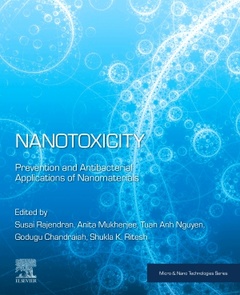Nanotoxicity Prevention and Antibacterial Applications of Nanomaterials Micro and Nano Technologies Series
Coordonnateurs : Rajendran Susai, Mukherjee Anita, Godugu Chandraiah, Shukla Ritesh K., Nguyen Tuan Anh

Nanotoxicity: Prevention, and Antibacterial Applications of Nanomaterials focuses on the fundamental concepts for cytotoxicity and genotoxicity of nanomaterials. It sheds more light on the underlying phenomena and fundamental mechanisms through which nanomaterials interact with organisms and physiological media. The book provides good guidance for toxic prevention methods and management in the manufacture/application/disposal. The book also discusses the potential applications of nanomaterials-based antibiotics.
The potential toxic effects of nanomaterials result not only from the type of base materials, but also from their size/ ligands/surface chemical modifications. This book discusses why different classes of nanomaterials display toxic properties, and what can be done to mitigate this toxicity. It also explores how nanomaterials are being used as antimicrobial agents, being used to purify air and water, and counteract a range of infectious diseases.
This is an important reference for materials scientists, environmental scientists and biomedical scientists, who are seeking to gain a greater understanding of how nanomaterials can be used to combat toxic agents, and how the toxicity of nanomaterials themselves can best be mitigated.
PART 1: BASIC PRINCIPLES 1. Nano-toxicity: An introduction 2. Nanoparticle–physiological media interactions 3. In vitro standard methods for cellular toxicity of nanoparticles 4. In vivo studies: Nanotoxicity and its biodistribution in organisms 5. In vitro and in vivo inflammatory effect of nanoparticles 6. Standard biological assays for nanotoxicity and its biodistribution
PART 2: TOXICITY OF NANOMATERIALS 7. Toxicity of metallic nanoparticles 8. Toxicity of metal oxide nanoparticles 9. Toxicity of ceramic nanomaterials 10. Toxicity of carbonaceous nanomaterials (CNTs, graphene) 11. Toxicity of polymeric nanomaterials
PART 3: PREVENTION OF NANOTOXICITY 12. General methods for detection and evaluation of nanotoxicity 13. General methods for mitigating nanotoxicity. 14. General regulations for safe manufacturer of nanomaterials 15. General regulations for safe application of nanomaterials 16. General regulations for safe disposal/exposure of nanomaterials 17. Nanomaterial waste management
PART 4: EMERGING ANTIBACTERIAL APPLICATIONS 18. Antibacterial activity of noble metals nanoparticles 19. Antibacterial activity of metal oxide nanoparticles 20. Antibacterial activity of noble metal- metal oxide hybrid nanoparticles 21. Antibacterial nanocoatings 22. Application in agri-food productions 23. Application in building materials 24. Antimicrobial nanomaterials for water disinfection 25. Antimicrobial nanomaterials for air disinfection/purification/remediation
PART 5: CONCLUSIONS AND FUTURE PERSPECTIVES 26. Current industrial scale up application 27. Future scope
Materials Scientists, Engineers and Toxicologists in academia
is Professor of Botany at the University of Calcutta, India. Her research focuses in the areas of cell biology, genetic toxicology, and nanobiotechnology
is Assistant Professor of Department of Regulatory Toxicology, National Institute of Pharmaceutical Education and Research, Hyderabad, India. His research focuses on the role of Telmisartan in improved intratumral distribution of nanoparticles.
is Assistant Professsor of Biological and Life Sciences, Ahmedabad University, India. His research focuses on applied nanotechnology, biotechnology, immunology and toxicology.
Tuan Anh Nguyen is Principal Research Scientist at the Institute for Tropical Technology, Vietnam Academy of Science and Technology, Hanoi, Vietnam. His research focuses on advanced nanomaterials and nanotechnology for corrosion and materials integrity in transportation systems. His research activities include smart coatings, conducting polymers, corrosion and protection of metals/concrete, antibacterial materials, and advanced nanomaterials.
- Explains the underlying phenomena and fundamental mechanisms through which nanomaterials interact with organisms and physiological media
- Outlines major methods for mitigating and prevention of nanotoxicity
- Discusses the applications of nanomaterials-based antibiotics
Date de parution : 04-2020
Ouvrage de 504 p.
19x23.3 cm
Thèmes de Nanotoxicity :
Mots-clés :
Nanotechnology; Nanomaterials; Nanotoxicity; Antimicrobial; Nanosafety



